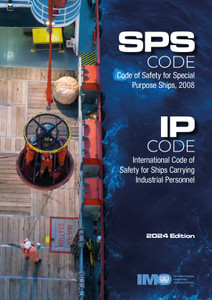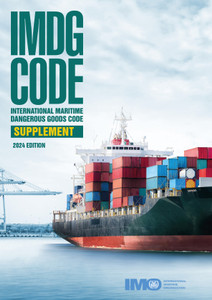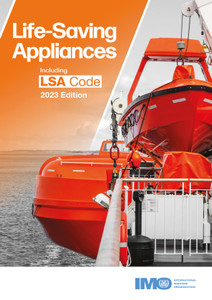
2023 Diving Code - 2024 Edition
The 2023 Diving Code was adopted by resolution MSC.548(107) and applies to ships of not less than 500 gross tonnage that have a diving system installed on or after 1 January 2024.
This publication contains the International Code of Safety for Diving Operations, 2023 (2023 Diving Code), which has been developed to enhance the safety of divers and diving support personnel, to facilitate the international movement and operation of diving units, and to provide a minimum international standard for the design, construction and survey of diving units to safely support diving operations.
The International Code of Safety for Diving Operations, 2023 (2023 Diving Code) has been developed to enhance the safety of divers and diving support personnel, to facilitate the international movement and operation of diving units, and to provide a minimum international standard for the design, construction and survey of diving units to safely support diving operations.
The 2023 Diving Code was adopted by the IMO Maritime Safety Committee (MSC) at its 107th session in June 2023 by resolution MSC.548(107) and applies to ships of not less than 500 gross tonnage that have a diving system installed on or after 1 January 2024. Administrations may also consider the application of the provisions of this Code to diving platforms of lesser tonnage and of any age. The 2023 Diving Code expands the scope of the Code of Safety for Diving Systems, 1995 (resolution A.831(19), as amended) and the Guidelines and specifications for hyperbaric evacuation systems (resolution A.692(17)).
The Code contains recommendations for the suitability of ships, floating structures and mobile offshore drilling units (MODUs) as platforms for diving systems, the design and testing of diving equipment and diving plants, and the conduct of diving operations, including hyperbaric evacuation. This publication also includes additional guidance and a model form of the Diving Unit Safety Certificate.
Contents
Foreword
International Code of Safety for Diving Operations, 2023
(2023 Diving Code)
Resolution MSC.548(107)
Preamble
Introduction
1 Goal
2 Application
3 Definitions
4 Alternative arrangements
5 Surveys and certification
6 Control
7 Structure of the Code
Chapter 1 ? General
1.1 Structure of this Code
1.2 Certificate and survey
1.3 Performance standards
Chapter 2 ? Diving unit principles ? Redundancy and integration
2.1 Goals
2.2 Functional criteria
2.3 Redundancy level and risks external to the diving activity
2.4 Redundancy and essential services
2.5 Enabling evacuation and protection from external events
2.6 Integration of the diving system and diving platform to create the diving unit 20
Chapter 3 ? Operational capabilities and limitations of diving platforms
for conducting safe diving operations
3.1 Goals
3.2 Functional criteria
3.3 Geographic location and environmental conditions
3.4 Structural integrity and imposed loads
3.5 Placement and configuration of diving system on diving platform
3.6 Subdivision and stability
3.7 Position keeping
3.8 Fire safety
3.9 Electrical power
3.10 Other services
Chapter 4 ? Diving system design, construction, installation,
testing and survey
4.1 Goals
4.2 Functional criteria
4.3 Diving system design
4.4 Pressure vessels for human occupancy (PVHO)
4.5 Other pressure vessels not intended for human occupancy
4.6 Wet bells and dive baskets used for the deployment
and recovery of surface orientated divers
4.7 Pipes, valves, fittings and hoses
4.8 Breathing gas supply, storage and temperature control
4.9 Diving launch and recovery systems (LARS)
4.10 Fire protection
4.11 Electrical system
4.12 Control systems
4.13 Communication and location systems
4.14 Maintenance and testing
4.15 Hyperbaric survival craft (HBSC)
Chapter 5 ? Diving operations and safety management
5.1 Goals
5.2 Functional criteria
5.3 Diving operations from the diving unit
5.4 Diving organization?s occupational health and safety management system
5.5 Manning and training
5.6 Emergency preparedness
5.7 Voyage planning
Annex 1 ? Additional guidance
Annex 2 ? Model form of diving unit safety certificate
Annex 3 ? Guidance on implementation of the International Code of Safety
for Diving Operations, 2023
Appendix 1 ? Certification examples for existing diving systems
Appendix 2 ? Example diving unit safety certificates
Appendix 3 ? Example record of equipment
IMO
As a specialised agency of the United Nations, the International Maritime Organization (IMO) is the global standard-setting authority for the safety, security and environmental performance of international shipping. Its main role is to create a regulatory framework for the shipping industry that is fair and effective, universally adopted and universally implemented.
In other words, its role is to create a level playing field so that ship operators cannot address their financial issues by simply cutting corners and compromising on safety, security and environmental performance. This approach also encourages innovation and efficiency.
Shipping is a truly international industry, and it can only operate effectively if the regulations and standards are themselves agreed, adopted and implemented on an international basis. And IMO is the forum at which this process takes place.
- Number of Pages:
- 94
- Published Date:
- April 2024
- Book Height:
- 0 mm
- Book Width:
- 0 mm
- Publication Date:
- April 2024
- Author:
IMO





